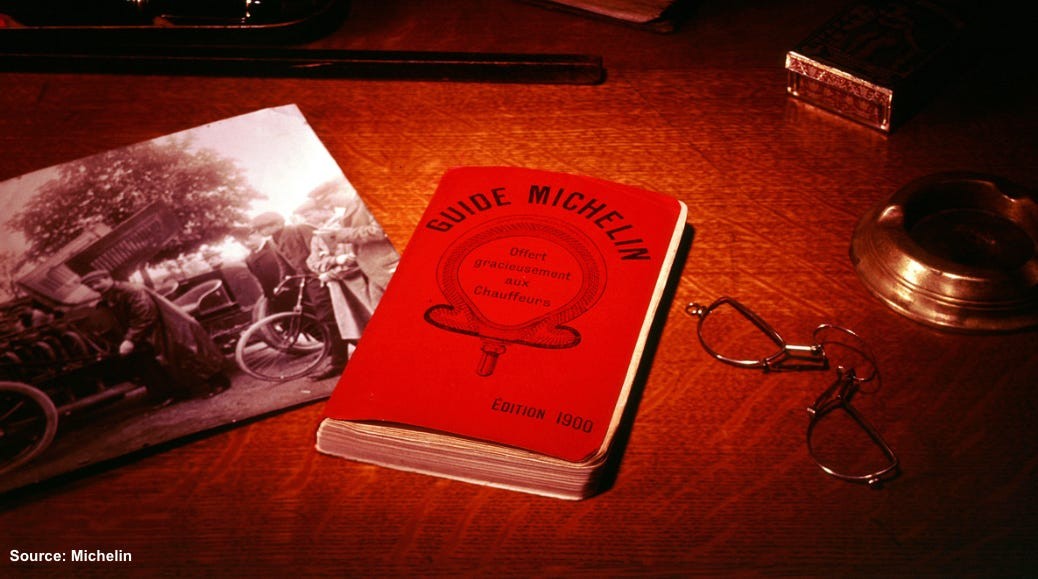How Does Michelin Guide Make Money? Discover the multifaceted revenue streams, from guide sales to strategic partnerships. CONDUCT.EDU.VN explores Michelin’s financial intricacies, underlining its brand promotion vehicle. Learn about its impact on tire sales and its role as a curator of dining experiences, emphasizing quality assessment and evaluation.
Table of Contents:
- The Origins of the Michelin Guide
- Michelin’s Secret Sauce: Signaling Quality
- Michelin Guide’s Revenue Streams: How They Make Money
- The Costs Behind the Stars: Michelin Inspector Expenses
- Why Chefs Relinquish Michelin Stars: The Pressure Cooker
- Alternative Voices: Criticism of the Michelin System
- The Michelin Guide’s Enduring Appeal: A Luxury Experience
- Michelin Guide and Brand Equity
- The Future of the Michelin Guide
- Frequently Asked Questions (FAQ)
1. The Origins of the Michelin Guide
The Michelin Guide’s story begins with the Michelin brothers, André and Edouard, who founded their tire company in France in 1889. In 1900, recognizing that increased car travel would boost tire sales, they created a guidebook for French motorists. This guide listed hotels and offered travel tips. In 1920, they started including independently reviewed restaurants. By 1926, they began awarding stars. The familiar 3-star ranking system was introduced in 1936. It wasn’t until 2005 that the Guide expanded to America and then Japan in 2007. It later continued into South America and Asia.
Here are some basic facts about the Michelin Guide:
- Global Presence: Approximately 3,200 Michelin-starred restaurants across 30 countries (over 600 in France, 400 in Japan, and 300 in Italy).
- Star Distribution:
- 1 star: 2,640 restaurants
- 2 stars: 417 restaurants
- 3 stars: 143 restaurants
Most Michelin-starred restaurants (more than 80%) have one star. Any kind of restaurant can earn a single star, even a street food vendor. However, jumping to two stars is difficult and depends on having excellent service and a great overall experience. France, Japan, the U.S., Italy, and Spain are the places where you’ll find the most 3-star restaurants. A two-star meal averages about $252, while a three-star meal averages $357.
2. Michelin’s Secret Sauce: Signaling Quality
A 2016 study by Bocconi University highlighted the Michelin Guide’s core strength: “Rankings act as essential signals indicating competitiveness of organizations, which are typically prevalent in industries characterized by uncertainty in the assessment of quality.” Michelin has transitioned from a simple directory of hotels and restaurants to a trusted source for culinary guidance.
The study examined Washington, D.C. restaurants before and after the Michelin Guide launched there. Restaurants that received stars increased their prices and used more sophisticated language in their menus. This included fancy cooking terms and higher-quality ingredients.
Joël Robuchon, who was awarded a record 32 Michelin stars, said:
- One Michelin star can boost business by 20%.
- Two stars increase business by 40%.
- Three stars can double business.
Michelin faces increasing competition from other awards like the James Beard Award, Zagat, and The New York Times reviews. Younger consumers also rely on social media for recommendations. Despite this competition, Michelin’s three-star ranking remains a prestigious honor. With only 143 restaurants worldwide holding this distinction, it is a highly sought-after luxury experience.
3. Michelin Guide’s Revenue Streams: How They Make Money
How does the Michelin Guide generate revenue? While Michelin doesn’t publicly release the Guide’s specific financial figures, several income streams can be identified.
- Guide Sales: Since 1900, over 30 million Michelin Guides have been sold. Assuming the Guide sells one million copies annually at $20 each, this generates approximately $20 million in sales.
- Digital Properties and Events: The Michelin Guide operates digital platforms, organizes events, and licenses its ranking system to third parties like TripAdvisor.
- Coverage Fees: Some countries pay Michelin to launch a Guide. For example, South Korea paid $1.8 million to launch the Seoul Guide. Thailand paid $4.4 million over five years for its Guide.
Impact on Tire Sales
One study found that introducing the Michelin Guide to a country can increase Michelin tire sales by 3%. Michelin’s annual sales are about $25 billion, so even small percentage changes have a significant impact. This may explain why Japan, a major automotive market, has so many three-star restaurants.
4. The Costs Behind the Stars: Michelin Inspector Expenses
The Michelin Guide doesn’t share detailed financial reports. However, a 2011 Financial Times report indicated the Guide loses about $24 million each year. While this is a substantial amount, it represents only 0.1% of Michelin’s total sales, making it a worthwhile marketing investment.
The most interesting expense is the cost of the Michelin inspectors. The Michelin Guide’s press kit describes the inspectors as the “main protagonists.” They have hospitality backgrounds and are Michelin employees, ensuring objectivity. Michelin pays for their meals to avoid conflicts of interest.
Inspectors live a demanding lifestyle:
- They eat about 250 anonymous meals each year.
- They spend 160 nights in hotels.
- They make 600 visits.
- They write over 1,000 reports.
Inspectors remain anonymous and only reveal their identity if they need additional information after the meal. Twice a year, they meet with the Guide’s editor to share notes and collectively decide on star ratings.
Estimating Inspector Expenses
Here’s a rough estimate of the costs associated with Michelin inspectors:
- Total Visits: The Guide covers over 15,000 restaurants. Different star levels receive varying numbers of visits: (3 stars = 10 visits) + (2 stars = 5 visits) + (1 star = 3 visits) + (no star = 1 visit) = 24,167 total visits.
- Cost of Visits: Assuming average costs of $450 for 3-star, $300 for 2-star, $100 for 1-star, and $100 for no-star restaurants, the total meal cost is $3.3 million.
- Number of Inspectors: If each inspector visits 200 restaurants annually, Michelin would need 121 inspectors.
- Inspector Salaries: Assuming each inspector earns $120,000 annually ($100,000 base + $20,000 for hotels), the total annual salary cost is $14.5 million.
- Total Inspector Expense: The estimated total annual inspector expense is $17.8 million.
Considering that a 30-second Super Bowl ad costs $6.5 million, spending $17.8 million on Michelin inspectors seems like an excellent investment.
5. Why Chefs Relinquish Michelin Stars: The Pressure Cooker
Michelin has established itself as the gold standard for restaurant quality. Its official 5-point ranking criteria include:
- Quality of products
- Mastery of flavor and cooking techniques
- The chef’s personality in the dining experience
- Harmony of flavors
- Consistency between visits
The star ratings are defined as:
- One Star: A very good restaurant in its category.
- Two Stars: Excellent cooking, worth a detour.
- Three Stars: Exceptional cuisine, worth a special journey.
However, terms like “harmony of flavors” and “worth a special journey” are subjective. Restaurants are constantly being judged, and any meal could affect their rating. Maintaining consistency is extremely stressful, and the fear of losing stars only adds to the pressure.
Several chefs have chosen to step away from the Michelin star system. Some notable examples:
- Eo Yun-gwong, a South Korean chef, sued Michelin to remove his stars, calling the system cruel.
- Julio Biosca, a Spanish chef, returned his star, tired of making complex menus.
- Frederick Dhooge, a Belgian chef, gave back his star to cook simpler dishes like fried chicken.
- Gordon Ramsay admitted he wept after losing a star.
- Bernard Loiseau, a top French chef, died by suicide in 2003, partly due to fears of losing a star.
6. Alternative Voices: Criticism of the Michelin System
Anthony Bourdain criticized how the Michelin system warps incentives and creativity. He noted that three-star restaurants often stick to the same menu to ensure consistency, which can stifle innovation.
Renee Redzepi, who ran the three-Michelin-star restaurant Noma, closed his original restaurant in 2016. He explained that success restrained his creativity and led to more conventional thinking.
Michelin argues that the stars are awarded to the restaurant, not the chef, so chefs cannot “give back” the stars. Bourdain famously compared the Michelin star process to sausage-making, saying, “No one wants to see how the hell it’s made.”
7. The Michelin Guide’s Enduring Appeal: A Luxury Experience
The Michelin Guide’s enduring appeal stems from its ability to signal quality and exclusivity. It offers a curated selection of dining experiences, making it a valuable resource for consumers. The Guide’s rigorous and anonymous inspection process adds credibility and trust.
Addressing Customer Challenges
Many individuals find it challenging to identify trustworthy dining options. The Michelin Guide simplifies this process by providing reliable recommendations.
How CONDUCT.EDU.VN Can Help:
CONDUCT.EDU.VN offers comprehensive information on various rating systems. It helps users understand the criteria and standards used by organizations like the Michelin Guide. Whether you’re a student, professional, or business leader, CONDUCT.EDU.VN provides the knowledge needed to make informed decisions.
8. Michelin Guide and Brand Equity
Michelin’s parent company benefits significantly from the brand equity and cultural prestige associated with the Guide. The Guide enhances Michelin’s overall brand image, particularly in the fine dining, hospitality, and travel sectors.
Michelin describes the Guide as “an unrivalled vehicle for promoting MICHELIN brand and its premium positioning.”
9. The Future of the Michelin Guide
The Michelin Guide continues to evolve, adapting to changing consumer preferences and technological advancements. It is expanding its coverage to new regions, embracing digital platforms, and incorporating user feedback. The Guide remains committed to its core mission of recognizing and celebrating culinary excellence.
Call to Action:
Are you seeking reliable guidance on dining etiquette or professional conduct? Visit CONDUCT.EDU.VN for detailed articles and resources. Understand the standards of excellence that drive organizations like the Michelin Guide.
- Address: 100 Ethics Plaza, Guideline City, CA 90210, United States
- WhatsApp: +1 (707) 555-1234
- Website: CONDUCT.EDU.VN
10. Frequently Asked Questions (FAQ)
Q1: How does the Michelin Guide define a one-star restaurant?
A: A one-star Michelin rating indicates “a very good restaurant in its category,” highlighting quality cooking and distinctive flavors.
Q2: What criteria do Michelin inspectors use to evaluate restaurants?
A: Michelin inspectors evaluate restaurants based on five criteria: quality of products, mastery of flavor and cooking techniques, the personality of the chef represented in the dining experience, harmony of flavors, and consistency between visits.
Q3: How do restaurants benefit from receiving Michelin stars?
A: Restaurants benefit from increased business, enhanced reputation, and greater recognition. Joël Robuchon noted that a one-star rating can increase business by 20%, two stars by 40%, and three stars by 100%.
Q4: Why have some chefs chosen to give back their Michelin stars?
A: Some chefs relinquish their stars due to the immense pressure to maintain consistency, the stress of constant evaluation, and the desire to pursue more creative and less constrained culinary approaches.
Q5: How does Michelin ensure the objectivity of its restaurant reviews?
A: Michelin ensures objectivity by employing anonymous inspectors with hospitality backgrounds, paying for their meals, and conducting thorough, consistent evaluations.
Q6: What are the key revenue streams for the Michelin Guide?
A: The key revenue streams for the Michelin Guide include guide sales, digital properties, events, licensing the ranking system, and coverage fees paid by countries to launch a guide.
Q7: How does the Michelin Guide contribute to Michelin’s overall brand equity?
A: The Michelin Guide enhances the company’s brand image, particularly in the fine dining, hospitality, and travel sectors. Michelin describes the Guide as “an unrivaled vehicle for promoting MICHELIN brand and its premium positioning.”
Q8: How is the Michelin Guide adapting to changing consumer preferences?
A: The Michelin Guide is adapting by expanding its coverage to new regions, embracing digital platforms, incorporating user feedback, and remaining committed to recognizing culinary excellence.
Q9: What is the estimated annual expense for Michelin inspectors?
A: The estimated total annual inspector expense is $17.8 million, including salaries, travel, and meal costs.
Q10: What impact does the Michelin Guide have on tire sales?
A: One study found that introducing the Michelin Guide to a country can increase Michelin tire sales by 3%.
By understanding how the Michelin Guide makes money, you can better appreciate its role in the culinary world and its impact on Michelin’s overall business strategy. For more insights on ethical standards and best practices, visit conduct.edu.vn.


